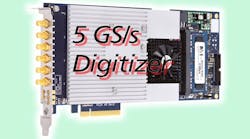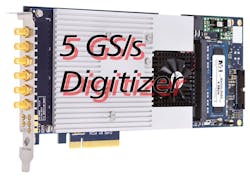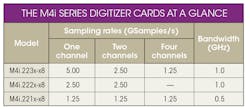This file type includes high resolution graphics and schematics when applicable.
Test instruments no longer require large enclosures to deliver heavyweight performance. A case in point is the M4i series of card-level high-speed digitizers from Spectrum Systementwicklung Microelectronic GmbH. These high-speed data-acquisition instruments each fit on a single circuit card—yet provide 8-b resolution at sampling rates to 5 GSamples/s for a single measurement channel, at bandwidths as wide as 1 GHz (see figure).
As many as eight of the cards can be synchronized by means of their own internal clock sources for tackling larger measurement assignments. Connecting one of the cards to a personal computer (PC) can transform the combination into a powerful test-and-measurement instrument; the card can perform continuous streaming of data to the PC at rates to 3.4 GBytes/s to create a “digital picture” of the most complex signals and waveforms.
The M4i series high-speed 8-b digitizers are available in single-, dual-, and four-channel versions with up to 4 GBytes of on-board digital memory (see table). They provide sampling rates to 5 GSamples/s on one channel, to 2.5 GSamples/s for two channels, and to 1.25 GSamples/s on four channels, with simultaneous sampling being performed on all channels. Higher-resolution 14/16-b versions of the digitizers are also available, with 2 GB of on-board data memory.
These digitizer cards include so much processing power—by merit of their own dedicated field-programmable gate arrays (FPGAs)—that they place only minimum loads on a connected system’s central processing unit (CPU). The cards use the on-board memory as a first-in-first-out (FIFO) buffer to ensure maximum data throughput over an extended operating period, even when a PC is involved in other activities.
These high-performance digitizer cards operate with four input level ranges, from ±200 mV to ±2.5 V. For controlling and operating the M4i series digitizers, the firm offers its SBench6 software. It supports all the key functions of the digitizer cards and provides display, storage, and analysis functions. The program provides both oscilloscope and transient recording modes, including data streaming. It features a segmented view which is well suited for burst-type signals. Segments can even be acquired with two different time bases and with trigger time stamping provided.
The cards feature full 32- and 64-b Linux support. They are shipped with precompiled kernel modules for the most common distributions, including RedHat, Fedora, Suse, Ubuntu, and Debian. With each digitizer card, the firm provides all the software necessary for linking the card’s operating software to other useful software tools, including LabVIEW from National Instruments, MATLAB from MathWorks, and Excel from Microsoft Corp.
Several options are available for the digitizer cards, including the use of an external reference clock (such as a 10-MHz oscillator) to synchronize the card with external instruments (including signal generators and analyzers). The cards are available with a gated sampling mode which allows data recording to be controlled by an external gate signal, using a programmable level to record only certain signal information. Also, a multiple recording mode allows the recoding of several trigger events with very short re-arming time, without needing to restart the card in between events to be recorded.
For connection to a PC or other system, each card requires a physical X8 or X16 PCIe slot with a Generation 2 or 3 interface. A variety of different product interfaces are available, such as with PCIe for fast data transfer speeds, with LXI for ease of remote control, and with PXI for ease of integration with other instrument modules.
Spectrum Systementwicklung Microelectronic GmbH, Ahrensfelder Weg 13-17, 22927 Grosshansdorf, Germany; +49 4102 6956 0, FAX: +49 4102 6956 0
This file type includes high resolution graphics and schematics when applicable.



